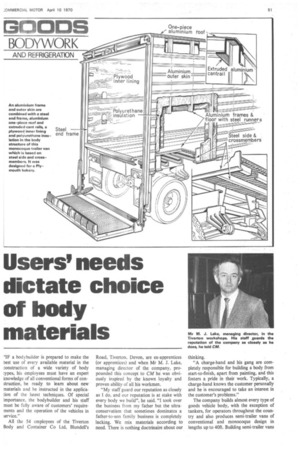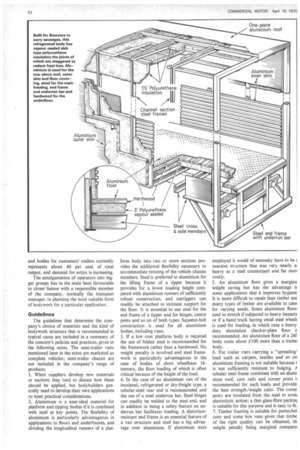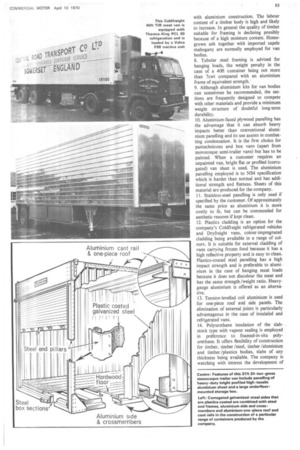Users' needs dictate choice of body materials
Page 53

Page 54

Page 55

Page 56

If you've noticed an error in this article please click here to report it so we can fix it.
'IF a bodybuilder is prepared to make the best use of every available material in the construction of a wide variety of body types, his employees must have an expert knowledge of al conventional forms of construction, be ready to learn about new materials and be instructed in the application of the latest techniques. Of special importance, the bodybuilder and his staff must be fully aware of customers' requirements and the operation of the vehicles in service."
All the 54 employees of the Tiverton Body and Container Co Ltd, Blundell's Road, Tiverton, Devon, are ex-apprentices (or apprentices) and when Mr M. J. Lake, managing director of the company, propounded this concept to CM he was obviously inspired by the known loyalty and proven ability of all his workmen.
"My staff guard our reputation as closely as I do, and our reputation is at stake with every body we build", he said. "I took over the business from my father but the ultraconservatism that sometimes dominates a father-to-son family business is completely lacking. We mix materials according to need. There is nothing doctrinaire about our thinking.
"A charge-hand and his gang are completely responsible for building a body from start-to-finish, apart from painting, and this fosters a pride in their work. Typically, a charge-hand knows the customer personally and he is encouraged to take an interest in the customer's problems."
The company builds almost every type of goods vehicle body, with the exception of tankers, for operators throughout the country and also produces semi-trailer vans of conventional and monocoque design in lengths up to 40ft. Building semi-trailer vans and bodies for customers' trailers currently represents about 40 per cent of total output, and demand for artics is increasing.
The amalgamation of operators into bigger groups has in the main been favourable to closer liaison with a responsible member of the company, normally the transport manager, in planning the most suitable form of bodywork for a particular application.
Guidelines
The guidelines that determine the company's choice of materials and the kind of bodywork structure that is recommended in typical cases are included in a summary of the concern's policies and practices, given in the following notes. The semi-trailer vans mentioned later in the notes are marketed as complete vehicles; semi-trailer chassis are not included in the company's range of products. _ 1. When suppliers develop new materials or sections they tend to dictate how these should be applied, but bodybuilders generally need to develop their own applications to meet practical considerations.
2. Aluminium is a near-ideal material for platform and tipping bodies if it is combined with steel at key points. The flexibility of aluminium is particularly advantageous in applications to floors and underframes, and dividing the longitudinal runners of a plat form body into two or more sections provides the additional flexibility necessary to accommodate twisting of the vehicle chassis members. Steel is preferred to aluminium for the lifting frame of a tipper because it provides for a lower loading height compared with aluminium runners of sufficiently robust construction, and outriggers can readily be attached to increase support for the floor. It is essential to use steel for the end frame of a tipper and for hinges, centre posts and so on of both types. Squeeze-bolt construction is used for all aluminium bodies, including vans.
3. If a low cost platform body is required the use of folded steel is recommended for the framework rather than a hardwood. No weight penalty is involved and steel framework is particularly advantageous in the case of bodies of short wheelbase 16tonners, the floor loading of which is often critical because of the height of the load.
4. In the case of an aluminium van of the insulated, refrigerated or dry-freight type, a tubular-steel rear end is recommended and the use of a steel underrun bar. Steel hinges can readily be welded to the steel end, and in addition to being a safety feature an underrun bar facilitates loading. A distortionresistant end frame is an essential feature of a van structure and steel has a big advantage over aluminium. If aluminium were
employed it would of necessity have to be g massive structure that was very nearly a heavy as a steel counterpart and far mon costly.
5. An aluminium floor gives a margina weight saving but has the advantage ir some applications that it improves hygiene It is more difficult to repair than timber an many types of timber are available to cata for varying needs. Some aluminium floor: tend to stretch if subjected to heavy impacts or if a hand truck having small steel wheel: is used for loading, in which case a heavy duty aluminium checker-plate floor iv recommended. An aluminium floor of a 24f body costs about £100 more than a timbei body.
6. For trailer vans carrying a "spreading' load such as carpets, textiles and so on aluminium framing is not suitable because i is not sufficiently resistant to bulging. tubular steel frame combined with an altuni nium roof, cant rails and corner‘ posts i recommended for such loads and 'provide the best strength /weight ratio. The come posts are insulated from the steel to avoic electrolytic action; a thin glass-fibre packim is suitable for this purpose and is easy to fit.
7. Timber framing is suitable for pantechni cons and some box vans given that timbe of the right quality can be obtained, th, weight penalty being marginal comparel with aluminium construction. The labour content of a timber body is high and likely to increase. In general the quality of timber suitable for framing is declining possibly because of a high moisture content. Homegrown ash together with imported sapele mahogany are normally employed for van bodies.
8. Tubular steel framing is advised for hanging loads, the weight penalty in the case of a 40ft container being not more than 7cwt compared with an aluminium frame of equivalent strength.'
9. Although aluminium kits for van bodies can sometimes be recommended, the sections are frequently designed to compete with other materials and provide a minimum weight structure of doubtful long-term durability.
10. Aluminium-faced plywood panelling has the advantage that it can absorb heavy impacts better than conventional aluminium panelling and its use assists in combatting condensation. It is the first choice for pantechnicons and box vans (apart from monocoque ,semi-trailer vans) but has to be painted. When a customer requires an unpainted van, bright flat or profiled (corrugated) van sheet is used. The aluminium panelling employed is to NS4 specification which is harder than normal and has additional strength and flatness. Sheets of this material are produced for the company.
11. Stainless-steel panelling is only used if specified by the customer. Of approximately the same price as aluminium it is more costly to fit, but can be commended for aesthetic reasons if kept clean.
12. Plastics cladding is an option for the company's Coldfreight refrigerated vehicles and Dryfreight vans, colour-impregnated cladding being available in a range of colours. It is suitable for external cladding of vans carrying frozen food because it has a high reflective property and is easy to clean. Plastics-coated steel panelling has a high impact strength and is preferable to aluminium in the case of hanging meat loads because it does not discolour the meat and has the same strength /weight ratio. Heavygauge aluminium is offered as an alternative.
13. Tension-levelled coil aluminium is used for one-piece roof and side panels. The elimination of external joints is particularly advantageous in the case of insulated and refrigerated vans.
14. Polyurethane insulation of the slabstock type with vapour sealing is employed in preference to foamed-in-situ polyurethane. It offers flexibility of construction for timber, timber /steel, timber /aluminium and timber /plastics bodies, slabs of any thickness being available. The company is watching with interest the development of polyurethane incorporating an aluminium foil vapour seal as it would enable a double vapour seal to be used.
15. Incorporating heat breaks round doors and rear frames is essential in building refrigerated bodies. Neoprene door seals are normally used combined with heavy-duty hinge equipment. Good maintenance is as important as a nominally low heat gain, inadequate maintenance being a common cause of a high heat gain. 16. Vans refrigerated by liquid nitrogen are particularly vulnerable thermally. To operate efficiently the equipment needs to be installed in a very "tight" body. Customers seem to favour liquid nitrogen for the transporting of frozen food, whereas generally speaking mechanical refrigeration is preferred for carrying produce, such as meat, in the higher temperature ranges.
17. The bonding of aluminium or plastics panels to body framework is not favoured because of the difficulty of repair.
18. Chassis for Tiverton monocoque semitrailer Trailervans are built with deep outer rails welded to channel-section crossmembers. The stressed-skin superstructure is of squeeze-bolt construction, the framework being of high-tensile aluminium and the panelling of profile aluminium. In addition to providing a substantial weight saving, monocoque construction affords a height advantage, notably a reduced fifth-wheel height.
19. Tiverton trailervans built on conventional chassis have the advantage that a wide range of framing materials and cladding can be accommodated, including aluminium-faced plywood or plastics panels. The semi-trailer chassis are based on I-beam main-members of high-yield steel and their relatively high weight is a favourable factor in the case of high vans (of say 9ft 6in. with a total height of 14ft) because it enhances stability. • 20. Use of draw-bar trailers would be welcomed because the bodybuilder would have "total control" over the unit without being subject to erratic chassis deliveries from the vehicle manufacturers which have become an increasing problem in the last 18 months.
21. Lutons are regarded as a thing of the past, particularly because they offer a relatively small increase in space and because they raise certain difficulties with bodies mounted on chassis with tilt cabs. The company takes the view that Lutons will largely disappear, although this view is resisted by their customers in the cattle container and pantechnicon fields. The Luton can be adapted in several ways to accommodate tilt cabs.
22. Polyurethane enamels are favoured for painting and are applied by the hot-spray method. The same method is used for oneoff bodies or the bodies of a fleet of vehicles.
















































































































































































